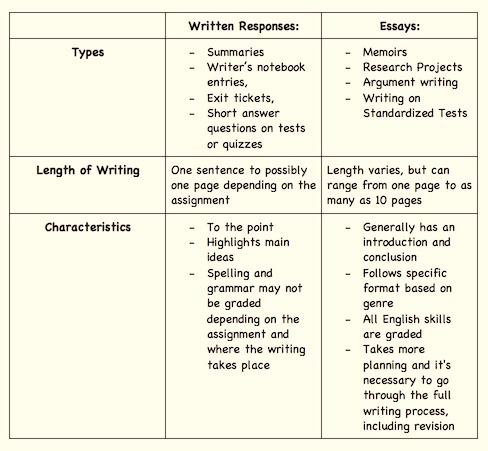Helping Today’s Students Gain Writing Endurance
A MiddleWeb Blog
A long breath – no, a long dramatic sigh – was let out by one of my 6th grade boys as he continued working on a piece of writing in my classroom a few weeks ago.
My students were working on an argumentative prompt related to school sports.
I felt this was a topic that would surely engage most of them – and I wasn’t wrong. They were working hard.
However as my students continued to write (and some continued to sigh) I began reflecting back over this past year, thinking about the progress these 6th and 7th grade writers have made and where they’ve had some struggles.
One of the biggest obstacles they’ve faced has been their lack of writing endurance. For some, any assignment longer than a paragraph creates sheer panic. You’d think I had just rolled a flash-bang into their classroom.
Remember the scene from A Christmas Story where the teacher announces it’s time for the class to write their holiday theme? The students start to whine and complain. Ralphie is the only one who’s excited because he can write about his passionate desire for a Red Ryder air rifle.
Teachers everywhere would love to see Ralphie’s level of commitment to writing among their own students. But how do we get there? At the beginning of the school year, I rarely see a student who’s eager to write more than a paragraph – or who has the endurance to even attempt a theme-length piece of writing.
What can we do about writing endurance?
My very first 6th grade writing assignment each year is a narrative piece. It’s called “About Me” and I assign this the first week of school for two reasons.
First, I want to get to know my students better without resorting to the most overused beginning-of-year prompt ever: “What did you do this past summer?”
Second, I want to see what kind of writing skills they are bringing into 6th grade without me giving them much instruction. The most I say to them is to make sure they have capital letters and proper punctuation, and that their sentences make sense.
Here are the things I notice as we work through the About Me assignment:
- Students always want to know how long a piece of writing has to be.
- Students don’t know what needs to be in an essay.
- Students struggle with putting similar ideas into distinct paragraphs and want to write one giant paragraph.
- Students’ writing endurance needs major improvement.
I realize that my students aren’t going to remember every detail about writing at the beginning of the year. But what can be nerve-racking is when students write a single six-sentence paragraph and think their work is “good enough” – no matter what the topic.
I spend most of the year trying to help students understand that simply writing one paragraph isn’t always going to get the job done. Furthermore, I have to get my students to understand that writing isn’t just about length – it’s about saying what we need to say. There doesn’t always have to be a specific length. This can be confusing to young writers (in part because they are used to teachers specifying length) and it definitely has to be defined clearly for them.
Some of my talking points
As my students finish their reflections on their first writing assignment, I begin to roll out the differences between written responses and an essay. In the table below are the talking points I go through with my students.
The table isn’t perfect and I am definitely open to suggestions on how to make it better for the next school year. I do feel my students gain a better understanding throughout the year of what the differences are between longer and shorter pieces of writing. But this still doesn’t address the issue of endurance.
Persevering is harder these days
So let me get back to what I mentioned at the beginning of this post concerning my student’s writing stamina. The struggle has been real for my 6th graders this year. After several months of observation, I came to the conclusion that if my students had to write longer than 15 minutes, they would become disengaged fairly quickly.
On my way home one day I processed what was causing the issue and I did reach a few conclusions. First, a majority of students write in quick spurts through social media platforms and text messaging, and most of that writing doesn’t take longer than a few minutes. Next, the curriculum in the lower grades doesn’t push the students hard enough to write for longer periods of time. There is an element of “learned helplessness” to this phenomenon.
There are many potential solutions to help build middle grades students’ writing endurance. Here are a few things I’ve tried this year with my 6th and 7th graders.

As the school year progresses, I add one minute each marking period. By the end of the year, I require my students to keep their pencils moving for 8 full minutes. Though this isn’t a complete solution for students who may one day be asked to write for hours, it does help build their stamina by developing the habit of some sustained writing (and thinking!).
During the school year I also added minutes to the students’ independent writing time. This time is set aside for work on bigger writing assignments and situations where they are learning the whole writing process. At the beginning of the year, I start with 15 minutes and add 5 minutes each marking period. By the end of the year, students should be able to work on writing for 30 full minutes.
Now, not all of my students can do this. As I circulate through the room and observe students write, I see some going back and forth between tabs, fidgeting with pencils, or just talking with their neighbors.
Focus is always a challenge with this age group, and now we have the “digital age” influences. Students are bombarded with information today, and they’ve mastered the new tools of communication to the point that they relay information quickly between themselves and other people with a minimum number of words.
In the more constrained environment of the classroom, many of them struggle with being able to sit still and just write. To help, I have added stretch breaks for them so they can get away from their seats (and their screens) for a few minutes.
The writing spaces gap
Whether discussing different types of writing or providing activities that can help build endurance, we need to plan our teaching with the awareness that our students live in several different writing spaces. Thanks to texting and social media, they may actually write more out of school than many of us did as kids. But it’s not the kind of writing we want them to concentrate on for school, college, and careers.
This gap between writing spaces is one of the reasons I have my students work on the grammar template throughout the year. I want to respect the activities that go on in their personal spaces, but I also want students to be able to have the awareness and endurance to complete formal writing assignments and to complete them by doing quality work.
The small steps I have taken so far are helping my students, but I also know there is room for improvement. Perhaps having my students write even more for English class can help as well. After all, Kelly Gallagher does tell us that we don’t have to grade every piece of writing we ask them to do.





































